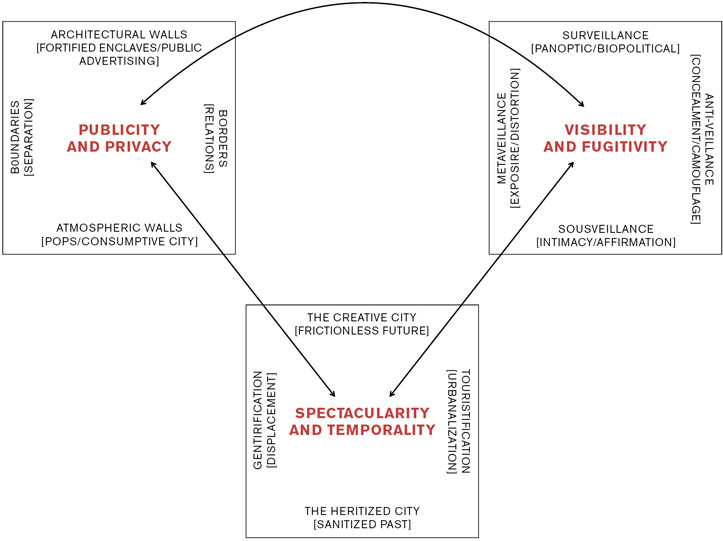III
Trace
Part III will focus on graffiti as a revelatory and reflexive artifact. It will explore it as a trace (from Latin tractus, a “drawing out”) exposing the increasing privatization, surveillance, and spectacularization of the urban realm. It will thus center on the city as the ecological frame from which graffiti emerges, exploring graffiti as a monument both made by, and in turn making, the landscape to which it is ineradicably affixed.
Chapter 7, “Publicity and Privacy,” will unpack the contradictions between exposure and restriction that graffiti outlines. Exploring the city as a site of borders and boundaries, it will examine privately owned public spaces, the designing-out of diversity as well as the privatizing of public space and practices alike. Here, however, the artistic reaction we will follow will be seen to encompass tactics of both trespass and amelioration, practices that seek to publicize the private and turn private spaces back into common-use. Chapter 8, “Visibility and Invisibility,” surveys the way graffiti evidences the decreasing privacy of the contemporary city. Investigating the ambiguities of appearance, the public exhibition of the graffiti image and the concomitant concealment of the graffiti body, the chapter will explore the city as a surveilled, panoptic site. Here we will address the way artists engage visible-invisibility alongside tactical modes of sous- and meta-veillance. And chapter 9, “Spectacularity and Temporality,” will consider the themes of both privatization in chapter 7 and visibility in chapter 8 through an exploration of the “creative” and “heritage” cities so prevalent in urban sites around the world. Examining the touristification and gentrification that these modalities enable, the focus will be on the nostalgic and kitsch relationship to the past and future they form. Here, however, it will be artistic techniques of erasure and the anti-spectacular we will find, a method of rejection over compliance enlisted to combat the spectacularized city. The monument revealed in part III will hence not emerge through a formal or a bodily structure, but rather exist through the construction of a “milieu, a know-how or a style” (Debray 1999: 34). It is thus a monument to the space of the border, to a mode of (in)visibility, to a technique of (anti)spectacularity we will see here, a monument-warning indexically marking out the prevailing conditions of the city itself.
